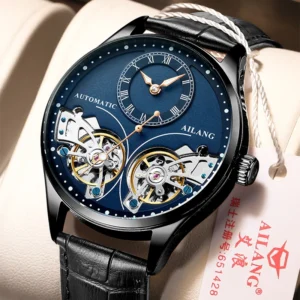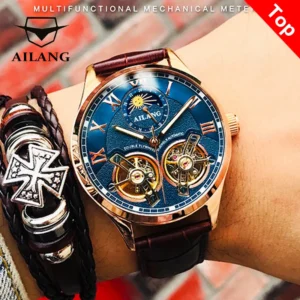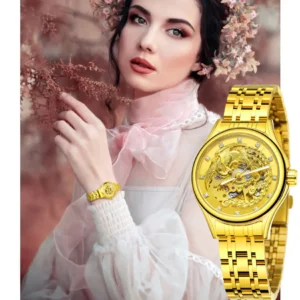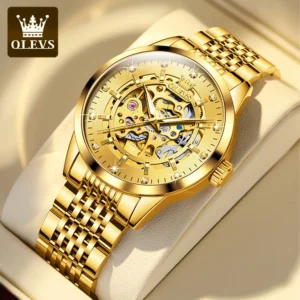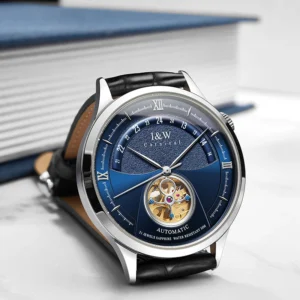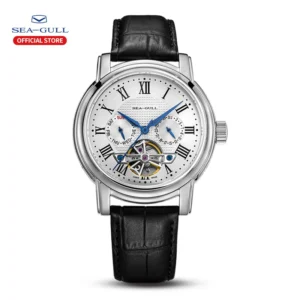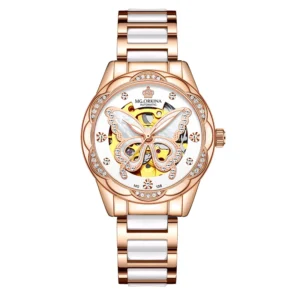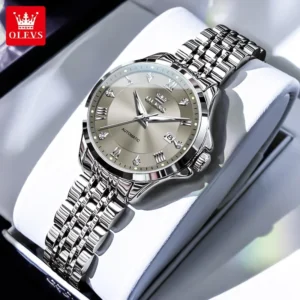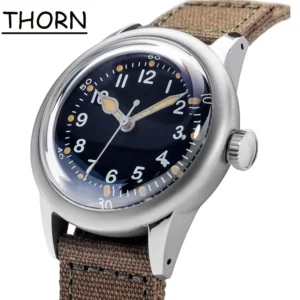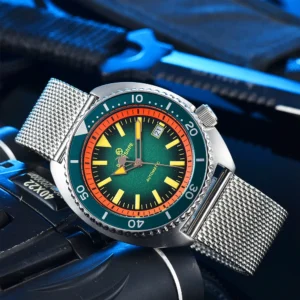Open Heart Automatic Watches
See your watch’s heart beat as open heart automatics reveal their intricate self-winding movement. Enjoy true mechanical artistry, always visible on your wrist.
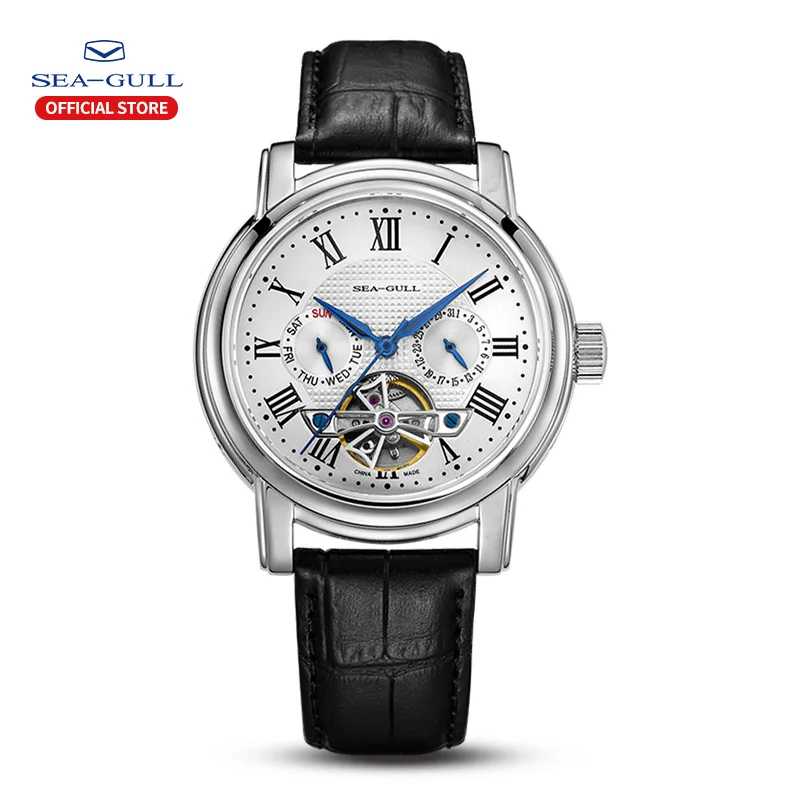
Showing all 7 results
Automatic Skeleton Watches, Mechanical Skeleton Watches, Open Heart Automatic Watches
Price range: $302.62 through $321.53 Select options This product has multiple variants. The options may be chosen on the product pageClassic Automatic Dress Watches, Moonphase Automatic Watches, Open Heart Automatic Watches
$192.99 Select options This product has multiple variants. The options may be chosen on the product pageAutomatic Skeleton Watches, Open Heart Automatic Watches
$98.36 Select options This product has multiple variants. The options may be chosen on the product pageAutomatic Skeleton Watches, Mechanical Skeleton Watches, Open Heart Automatic Watches
Price range: $185.19 through $196.96 Select options This product has multiple variants. The options may be chosen on the product pageAutomatic Skeleton Watches, Classic Automatic Dress Watches, Mechanical Skeleton Watches, Open Heart Automatic Watches
Price range: $411.33 through $422.65 Select options This product has multiple variants. The options may be chosen on the product pageClassic Automatic Dress Watches, Day Date Automatic Watches, Open Heart Automatic Watches
Price range: $513.84 through $517.07 Select options This product has multiple variants. The options may be chosen on the product pageAutomatic Skeleton Watches, Open Heart Automatic Watches
Price range: $111.96 through $115.96 Select options This product has multiple variants. The options may be chosen on the product page
Showing all 7 results
The Allure of Open Heart Automatic Watches
The magic of an open heart automatic watch lies in its captivating transparency. These remarkable timepieces feature a carefully crafted aperture on the dial that reveals the beating heart of the watch—the balance wheel and escapement—offering a mesmerizing glimpse into the soul of mechanical watchmaking.
The appeal is undeniable: with each flick of your wrist, light dances across the exposed components as they perform their intricate ballet. The balance wheel oscillates with hypnotic rhythm, creating a dynamic, ever-changing display that transforms a simple timepiece into a miniature kinetic sculpture for your wrist.
At Sharp Aspect, we celebrate this perfect marriage of technical precision and aesthetic beauty. Open heart watches represent more than functional timekeeping—they embody the transparent artistry of horological tradition. The visible mechanics serve as a constant reminder of the craftsmanship within, connecting wearer to watchmaker across time and space. This window into the watch’s inner workings transforms the experience of checking the time into a moment of appreciation for mechanical ingenuity.
How Open Heart Mechanisms Work
The open heart design represents a masterful balance between revealing mechanical beauty and maintaining structural integrity. Unlike fully skeletonized watches that expose most of the movement, open heart watches feature a strategically placed aperture—typically positioned between the 6 and 9 o’clock markers—that showcases the most dynamic components.
What you’re seeing through this window is the balance wheel and escapement, often referred to as the “heart” of the watch. These components regulate time by controlling the release of energy from the mainspring. The balance wheel oscillates at a consistent rate (typically 21,600 to 28,800 vibrations per hour), while the escapement delivers precisely measured impulses.
Watch manufacturers employ various finishing techniques to enhance the visual appeal of these exposed elements. Polished surfaces, beveled edges, and sometimes even blued screws create striking contrasts that highlight the craftsmanship. Different brands approach open heart design with unique signatures—some prefer minimal, precisely cut apertures, while others incorporate the opening as part of a larger aesthetic motif that complements the overall dial design.
The Self-Winding Magic: Automatic Movement
The true marvel of an open heart automatic watch extends beyond its visual appeal to its self-sustaining nature. Automatic movements, also called self-winding, harness the kinetic energy of your natural wrist movements to power the timepiece—no batteries required.
The key component in this ingenious system is the rotor, a semicircular weight that pivots freely with your movements. As you go about your day, the rotor spins, winding the mainspring and storing energy. This perpetual energy system is partially visible through the open heart, allowing you to witness firsthand how your movement translates into the watch’s power.
One of the most distinguishing characteristics of automatic movements is the smooth, sweeping motion of the seconds hand, contrasting with the tick-tick-tick of quartz watches. When fully wound, these movements typically offer power reserves ranging from 36-80 hours, meaning your watch can continue running even when not worn for a day or two.
This self-sustaining ecosystem represents centuries of watchmaking evolution, perfecting a mechanical system that operates without electronic components—a testament to human ingenuity that continues to fascinate in our digital age.
Craftsmanship Elements: What Sets Quality Apart
The open heart design doesn’t just reveal the watch’s inner workings—it showcases the manufacturer’s attention to detail and commitment to craftsmanship. Even through a relatively small aperture, discerning eyes can identify several hallmarks of quality.
The finishing techniques applied to visible components speak volumes about the watch’s overall caliber. Geneva stripes (côtes de Genève), creating parallel decorative lines across bridges or plates, catch light beautifully. Perlage (circular graining) produces overlapping circular patterns that add texture and dimension. Particularly in higher-end pieces, you might spot blued screws—a traditional technique where steel screws are carefully heated to achieve a rich blue hue that resists corrosion.
Jewel bearings—synthetic rubies or sapphires visible as small red dots—serve a crucial functional purpose by reducing friction at pivot points, ensuring smoother operation and greater longevity. The precision with which these components are arranged and regulated directly impacts timekeeping accuracy.
In quality open heart watches, different surface treatments create visual contrast that animates the display as light plays across the various finishes. This attention to aesthetic detail, even on components that most owners will only see through a small window, represents the watchmaker’s philosophy that excellence should extend to every element, visible or not.
Style Variations: Finding Your Perfect Open Heart Design
Open heart automatic watches span a remarkable range of aesthetic approaches, ensuring there’s a perfect match for every personal style. At the most fundamental level, dial variations set the tone—from minimalist designs where the open heart is the central focus to richly textured dials where the aperture becomes part of a more complex visual landscape.
Case materials significantly impact both appearance and wearability. Stainless steel offers versatile durability, while precious metals like rose gold provide warmth and luxury. Modern PVD coatings can create dramatic black or gunmetal finishes that frame the open heart with contemporary contrast.
Size considerations matter greatly with open heart designs. Larger cases (40-44mm) make the mechanical display more prominent and easier to appreciate, while smaller cases (36-39mm) integrate the feature more subtly—ideal for those preferring dress watches with mechanical intrigue.
Dial color choice plays a crucial role in framing the open heart feature. Lighter dials create stark contrast with the mechanical elements, highlighting them dramatically, while darker dials create a more cohesive, integrated appearance where the movement seems to emerge organically from the background.
Caring for Your Open Heart Automatic Watch
The exposed nature of open heart watches requires thoughtful care to preserve both function and beauty. Unlike fully sealed watches, these timepieces demand particular attention to keeping dust and moisture at bay, as even tiny particles can affect both aesthetics and performance.
For optimal performance, automatic watches should maintain consistent power. If worn daily, your natural movement typically provides sufficient winding. For occasional wear, a watch winder can mimic wrist movement, keeping the watch ready and reducing strain on components that occurs during starting after prolonged rest.
Water resistance deserves special attention—always ensure the crown is properly pushed in or screwed down before exposure to moisture. Even watches rated for water resistance should avoid prolonged submersion.
Professional servicing every 3-5 years is recommended to ensure internal components remain properly lubricated and adjusted. Between services, store your watch away from strong magnetic fields, which can disrupt the delicate balance mechanism that’s visible through the open heart.
How Do Open Heart Watches Compare to Fully Skeletal Designs?
Open heart watches and skeleton watches represent different approaches to mechanical transparency, each with distinct advantages. While open heart watches maintain most of the traditional dial, revealing only a strategic window to the movement, skeleton watches remove much of the dial material to expose as much of the mechanism as possible.
This fundamental difference affects both aesthetics and functionality. Open heart designs typically offer superior readability, as the hour markers and hands stand out clearly against a solid dial. Mechanical skeleton watches, by contrast, provide a more comprehensive view of the movement but sometimes sacrifice some legibility in the process.
From a manufacturing perspective, fully skeletonized designs are generally more complex to produce, often commanding higher price points. The open heart approach represents a thoughtful compromise—offering mechanical fascination while maintaining the classic watch aesthetic and typically at a more accessible entry point.
Open Heart Watches: A Gateway to Horological Appreciation
For many enthusiasts, an open heart automatic watch serves as the perfect introduction to the world of fine mechanical watchmaking. By offering a literal window into the movement without fully committing to the more dramatic aesthetic of skeleton watches, these timepieces provide an accessible entry point to horological appreciation.
Watching the balance wheel oscillate with each movement of your wrist creates an emotional connection to the craftsmanship inside—a constant reminder that your timepiece is alive with mechanical ingenuity rather than simply powered by a battery. This visible connection often sparks deeper curiosity about watchmaking, leading many collectors to begin their journey with an open heart piece before exploring more complex mechanical expressions.
At Sharp Aspect, we believe these watches perfectly embody the philosophy that fine timepieces should engage both visually and mechanically, inviting wearers into the centuries-old conversation between art and engineering that defines exceptional watchmaking.

